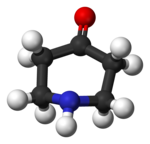4-Piperidinone

| |

| |
| Names | |
|---|---|
| Preferred IUPAC name
Piperidin-4-one | |
| Other names
4-Piperidone
Azinanone Azinan-4-one | |
| Identifiers | |
3D model (JSmol)
|
|
| ChemSpider | |
| ECHA InfoCard | 100.050.420 |
| EC Number |
|
PubChem CID
|
|
| UNII | |
CompTox Dashboard (EPA)
|
|
| |
| |
| Properties | |
| C5H9NO | |
| Molar mass | 99.133 g·mol−1 |
| Boiling point | 79 °C (174 °F; 352 K) |
| Hazards | |
| GHS labelling: | |

| |
Signal word
|
Warning |
| H315, H319, H335 | |
| P261, P264, P271, P280, P302+P352, P304+P340, P305+P351+P338, P312, P321, P332+P313, P337+P313, P362, P403+P233, P405, P501 | |
| NFPA 704 (fire diamond) | 
1
3 |
| Flash point | 91 °C (196 °F; 364 K) |
| Related compounds | |
Related compounds
|
Piperidine; 2-Piperidinone |
Except where otherwise noted, data are given for materials in their standard state (at 25 °C [77 °F], 100 kPa). | |
| Infobox references | |
4-Piperidinone is a derivative of piperidine with the molecular formula C5H9NO. 4-Piperidone is used as an intermediate in the manufacture of chemicals and pharmaceutical drugs.
Piperidones[]
Piperidones are a class of chemical compounds sharing the piperidone skeleton. A classic named reaction for the synthesis of piperidones is the Petrenko-Kritschenko piperidone synthesis which involves combining an alkyl-1,3-acetonedicarboxylate with benzaldehyde and an amine.[1] This multicomponent reaction is related to the Hantzsch pyridine synthesis.
See also[]
References[]
- ^ Petrenko-Kritschenko P, Zoneff N (March 1906). "Ueber die Condensation von Aceton‐dicarbonsäureestern mit Benzaldehyd unter Anwendung von Ammoniak". Berichte der Deutschen Chemischen Gesellschaft (in German). 39 (2): 1358–61. doi:10.1002/cber.19060390234.
This article needs additional citations for verification. (December 2016) |
Categories:
- 4-Piperidinones
- Heterocyclic compound stubs